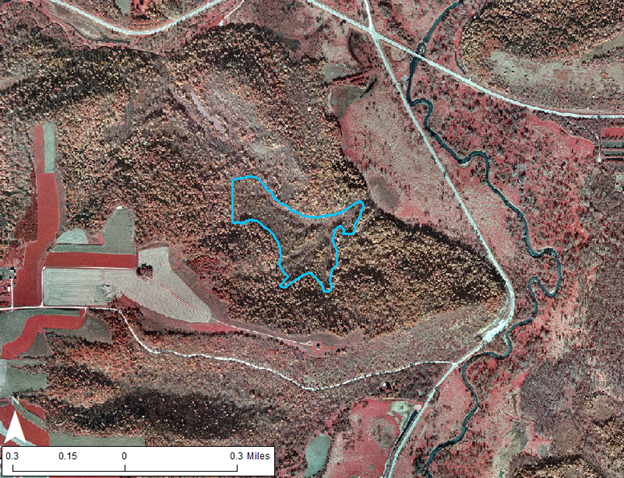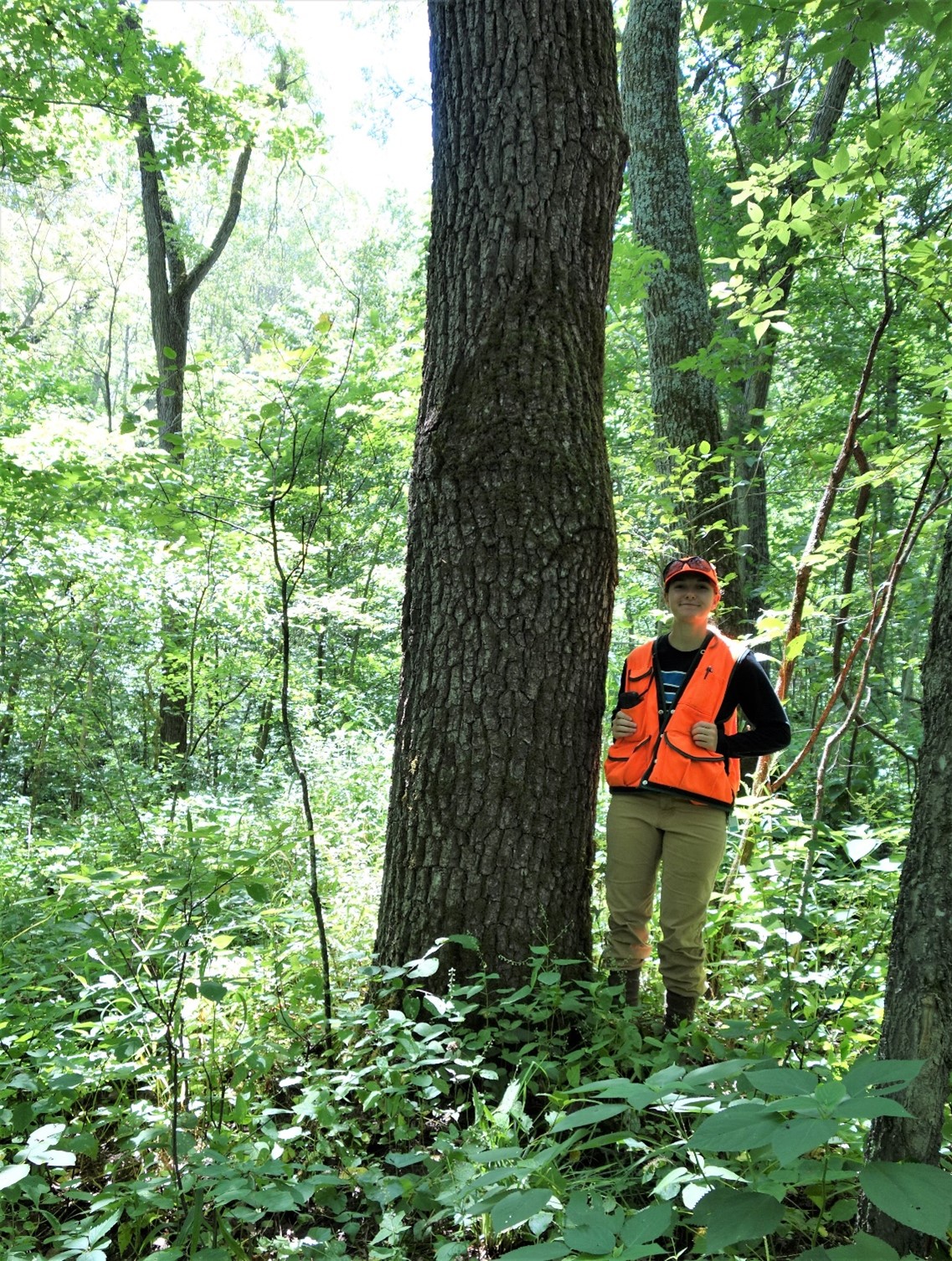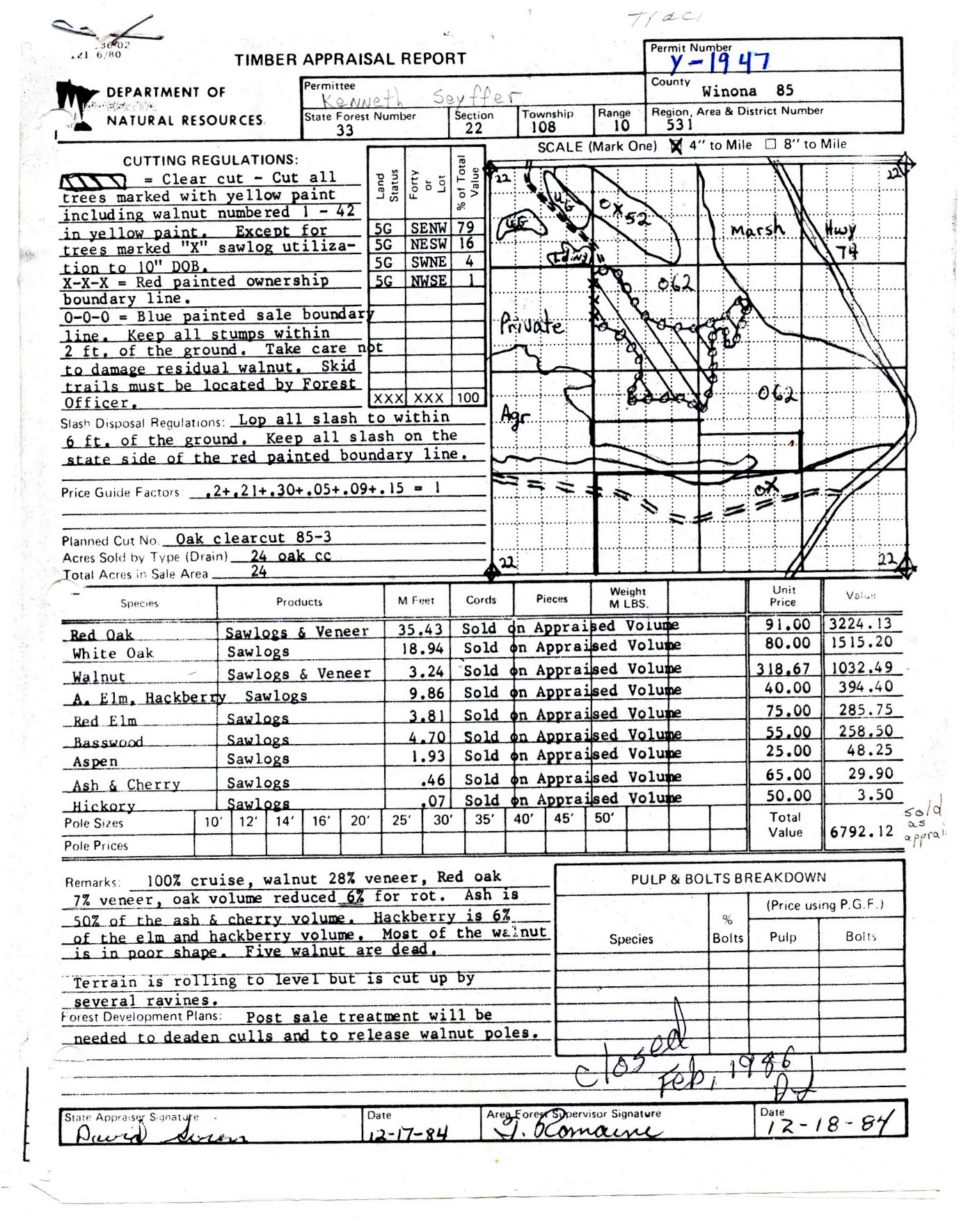Overview
This case study documents stand conditions 34 years after a timber harvest with objectives of wildlife habitat maintenance and improvement through oak regeneration and black walnut competition release. Habitat maintenance and improvement is the main driver for prescriptions on lands administered by the Division of Fish and Wildlife such as this stand. The silvicultural prescription was a combination of clearcut with reserves harvest on most of the site, with more of a selection harvest in portions with a significant black walnut component: there were more residuals in areas with more black walnut, and black walnut was typically reserved. The silvicultural strategies employed were:
- Re-initiate a stand as would severe windthrow to create open to very large gap habitat.
- Maintain a stand as would selective windthrow by removal of canopy trees in large gaps.
- Maintain a stand as would natural senescence, disease, or selective windthrow to create small-gap habitat.
In 2020, the stand is a 34-year-old mixed hardwood forest, with a good component of red and white oak and a variety of other hardwood species including basswood, black cherry and elm. The oak component is from a combination of harvest residuals as well as some regenerated trees. The stand also contains a good component of healthy black walnut trees ranging in size from 5 to 25 inches DBH.
An interesting feature is that a significant population of a state-listed Species of Special Concern plant was found during field observations of understory plants in 2020.

Figure 1: 2016 color infrared aerial photo showing case study site and surrounding area with study site shown with blue boundary
Silviculture Objectives
- Regenerate a mature oak and walnut stand to a young stand with similar composition.
- Maintain and improve wildlife habitat with a significant component of oak and black walnut trees in the new stand. One of the most important contributions to wildlife from oak and black walnut is mast, or acorns and walnuts which are an important seasonal food source for numerous wildlife species.
Pre-treatment stand description and condition
Stand establishment and management history
In 1984, the stand was dominated by mature red and white oak, along with some elm, basswood, black walnut and several other hardwood species in small volumes. The oaks probably averaged 100 to 120 years old at harvest. Most of the mature oak stands in southeastern Minnesota of that vintage originated after control of regular fires and post European settlement. The stand would have been part of a privately owned farmstead until the state obtained it, so it probably had a history of use as a woodlot and wooded pasture prior to state ownership.
Pre-treatment species composition
Table 1: 1984 Timber Sale Appraisal Volume Estimates by Species
Species | Quantity (MBF) |
Red Oak | 35.4 |
White Oak | 18.9 |
American Elm | 9.3 |
Basswood | 4.7 |
Red Elm | 3.8 |
Black Walnut | 3.2 |
Aspen | 1.9 |
Hickory | .7 |
Hackberry | .6 |
Ash | .2 |
Black Cherry | .2 |
Total | 78.9 |
Pre-treatment forest health issues
As is common for stands of its age in southeastern Minnesota, the stand had a modest amount of heart rot.
Landowner objectives/situation
Wildlife Management Areas (WMAs) are part of Minnesota's outdoor recreation system and are established to protect those lands and waters that have a high potential for wildlife production, public hunting, trapping, fishing, and other compatible recreational uses. They are the backbone of the DNR's wildlife management efforts in Minnesota and are key to protecting wildlife habitat for future generations by providing Minnesotans with opportunities for hunting, fishing, and wildlife watching, and by promoting important wildlife-based tourism in the state. Source: Whitewater Wildlife Management Area Master Plan.
The Minnesota DNR goal for oak forest acreage at the time of project initiation was to maintain as much of it as possible through regeneration of mature stands.
Silviculture prescription
The following series of treatments were implemented:
Treatment | Date | Description | Acres Treated |
Timber Appraisal and Silvicultural Assessment | Fall 1984 | Timber was appraised for sale, and the stand was assessed to determine a silvicultural strategy. This included a survey of advance regeneration. | 24 |
Clearcut with Reserves Harvest | Winter of 1985/86 | Winter clearcut with reserves harvest.
| 24 |
Post-sale killing of elm, ironwood and boxelder | Summer 1986 | Competing boxelder, elm, ironwood and hickory trees were killed by girdling with a chainsaw, and applying Tordon herbicide to the girdle wound. | 24 |
What actually happened during the treatment
The treatment was implemented as prescribed above.
Post-treatment assessment
The silvicultural treatment has resulted in a diverse 34-year-old central hardwoods stand with significant mast-producing oak and black walnut components as of 2020
Overstory: As shown in Table 2 below, red and white oak, black walnut, and basswood have the greatest basal area and frequency on plots of any species. Oak and walnut are all important mast-producers as a seasonal wildlife food source. Basswood also has a significant presence. A variety of other hardwood species are also scattered through the stand in smaller amounts, including elm, bitternut hickory, hackberry and several others.
Table 2: Tree species basal area in feet2/acre by DBH class, and frequency on BA plots in 2020
Diameter Class | 5-10” DBH* | 10-15” DBH | 15-20” DBH | >20” DBH | Total | ||||
Species | BA | Freq | BA | Freq | BA | Freq | BA | Freq | BA |
Black Walnut | 2.27 | 14% | 3.2 | 27% | 6.4 | 36% | 5.0 | 41% | 16.9 |
Red Oak | 3.2 | 23% | 1.4 | 14% | 3.2 | 27% | 1.4 | 14% | 9.2 |
White Oak | 2.3 | 18% | 4.1 | 23% | 3.6 | 27% | 0 | 0% | 10 |
Basswood | 5.0 | 36% | 4.1 | 36% | .5 | 5% | 0 | 0% | 9.6 |
Elm | 5.9 | 32% | .9 | 9% | 0 | 0% | 0 | 0% | 6.8 |
Bitternut Hickory | 5.9 | 36% | .5 | 5% | 0 | 0% | 0 | 0% | 6.4 |
Hackberry | 4.5 | 36% | 0 | 0% | 0 | 0% | 0 | 0% | 4.5 |
Bur Oak | 0 | 0% | .5 | 5% | 0 | 0% | 0 | 0% | 0.5 |
Sugar Maple | .5 | 5% | .5 | 5% | 0 | 0% | 0 | 0% | 1.0 |
Ash | .5 | 5% | .5 | 5% | 0 | 0% | 0 | 0% | 1.0 |
Black Cherry | .5 | 5% | 0 | 0% | 0 | 0% | 0 | 0% | 0.5 |
Butternut | 0 | 0% | 0 | 0% | 0 | 0% | .5 | 5% | 0.5 |
Total BA |
| 66.9 | |||||||
*NOTE: Due to average growth rates, we estimate that half or more of trees from 5 to 10” DBH were those regenerated post-harvest, and that virtually all trees over 10” DBH in 2020 were harvest residuals.

Figure 2: Forestry Intern Elizabeth Reeves near a large black walnut tree in the summer of 2020
Regeneration:
Regeneration data for trees below 5” DBH is shown in Table 3. We want to emphasize 4 things related to their potential impact on the stand moving forward.
- There are fair components of post-harvest regenerated 3-5 inch DBH black cherry and red oak small trees, but not nearly as much oak as we would have liked. Both species provide seeds that are used by wildlife as a seasonal food source.
- There are also lesser but still significant components of 3 to 5 inch DBH hickory, basswood, walnut, white oak and hackberry trees to provide stand diversity and seed crops for wildlife. There is also a large elm component.
- Sugar Maple regeneration was present on only one plot (4% frequency) during our sampling. This means that its impact on future stand makeup will be minimal.
- Invasive buckthorn and honeysuckle are present, but at relatively low levels. This means that they are not having a huge impact now, and any future control efforts should be achievable at reasonable cost.
Table 3: Stems/acre of regeneration by species, size class and plot frequency in 2020
Size Class | Regenerants: < 1’ tall | Seedlings: ≥1’ tall and < 1” DBH | Saplings: 1” to 3” DBH | Small Trees: 3” to 5” DBH | ||||
Species | Stems/ Acre | Freq | Stems/ Acre | Freq | Stems/ Acre | Freq | Stems/ Acre | Freq |
Elm | 591 | 27% | 182 | 14% | 91 | 14% | 64 | 41% |
Basswood | 227 | 14% | 0 | 0% | 23 | 5% | 50 | 23% |
Black Cherry | 136 | 9% | 227 | 14% | 0 | 0% | 36 | 18% |
Bitternut Hickory | 91 | 9% | 91 | 9% | 23 | 5% | 18 | 14% |
Red Oak | 182 | 14% | 0 | 0% | 45 | 5% | 23 | 23% |
Ash | 1182 | 45% | 1227 | 36% | 136 | 18% | 14 | 14% |
Black Walnut | 136 | 14% | 91 | 9% | 0 | 0% | 9 | 9% |
White Oak | 591 | 9% | 0 | 0% | 0 | 0% | 5 | 5% |
Hackberry | 0 | 0% | 136 | 9% | 0 | 0% | 0 | 0% |
Ironwood | 45 | 5% | 45 | 5% | 0 | 0% | 0 | 0% |
Sugar Maple | 43 | 5% | 0 | 0% | 0 | 0% | 0 | 0% |
Honeysuckle | 45 | 5% | 0 | 0% | 0 | 0% | 0 | 0% |
Buckthorn | 91 | 9% | 227 | 14% | 0 | 0% | 0 | 0% |

Figure 3: A typical portion of the stand in 2020. Note that full crown closure has not yet been achieved on much of the site, as shown by the amount sunlight hitting the understory and presence of sun-loving raspberry.

Figure 4: ECS Specialist Michelle Martin, Forester Dan Kuttschied and Forestry Intern Elizabeth Reeves in a typical portion of the stand in the summer of 2020
The oak component in the current stand is a combination of harvest residuals (many of which were released from competition by the harvest) and also trees that have regenerated post-harvest.
There is not nearly as much post-harvest oak regeneration as we would have liked, but there is some.
Between those oaks regenerated post-harvest, and the residual stems that were released, there is currently a significant oak component to the stand in 2020.
Harvest activity impacted the current oak component in the stand by releasing some residual trees, and by enabling regeneration of some oak trees after harvest.
- In Table 2, the harvest residuals are all oaks over 10” DBH, and about half of those range from 5”-10” DBH.
- In Tables 2 and 3, the post-harvest regenerated oaks are all those from 3”-5” DBH, and about half of those range from 5”-10” DBH.
Non-tree understory vegetation composition
In terms of non-tree vegetation, we found typical plants found in MHs37 native plant communities including herbaceous plants like white snakeroot (Ageratina altissima), Pennsylvania sedge (Carex pennsylvanica), pointed leaved tick trefoil (Desmodium glutinosum), lady fern (Athyrium Filix-femina), interrupted fern (Osmunda claytoniana), maidenhair fern (Adiantum pedatum), wild ginger (Asarum canadense), trillium sp. (Trillium sp.), bloodroot (Sanguinaria canadensis) , wild coffee (Triosteum perfoliatum), wild geranium (Geranium maculatum), jack-in-the-pulpit (Arisaema triphyllum); shrubs like nannyberry (Viburnum lentago), grape leaved honeysuckle (Lonicera reticulata), hawthorn (Crataegus sp.), grey dogwood (Cornus racemosa), pagoda dogwood (Cornus alternifolia), prickly-ash (Zanthoxylum americanum), gooseberries (Ribes spp.), etc. There were some earlier successional species present in large patches still including raspberries and blackberries (Rubus spp.). Most of the stand doesn’t have a fully closed canopy yet. Notably, we found fairly large patches of a special concern plant throughout the stand. We don’t know if this plant was there prior to harvest or if it came in later. From what we could tell, this particular population was doing well. This particular species is only known to occur in closed canopy mesic hardwood forests with canopies of sugar maple, basswood, and red oak.
Invasive Species
As noted above, we observed a few exotic plants, including buckthorn (Rhamnus cathartica), honeysuckle (exotic Lonicera spp.). These shrubs were scattered, but not common in the stand. However, they are something to be aware of and consider in future management. We also came across a few small patches of garlic mustard (Alliaria petiolata).
Plans for Future Treatments
Monitor the stand through periodic inventory surveys.
Costs and economic considerations
Costs
Timber sale setup and administration: $ 75/ac (1984 dollars)
Post-sale killing of competing undesirable trees: $ 75/ac (1986 dollars)
TOTAL: $ 150/ac (1984-86 dollars)
Revenue
Timber sale: $ 283/ac (1986 dollars)
TOTAL: $ 283/ac. (1986 dollars)
Other notes
We found a good population of a Special Concern listed plant in the understory of this site.
The data-gathering assistance of Christine Johnson, Forester Dan Kuttschied, and Forestry Intern Elizabeth Reeves is gratefully acknowledged.
The review and editing assistance provided by MNDNR Silviculture Program Consultant Mike Reinikainen is gratefully acknowledged.
This case study was developed with support from the United States Department of Agriculture's National Institute for Food and Agriculture, Renewable Resources Extension Act. Project #2021-46401-35956, principal investigator Eli Sagor, University of Minnesota.
Summary
A clearcut with reserves harvest with post-sale tree competition control produced a diverse hardwood stand with significant oak and black walnut components in 2020
We did not get nearly as much post-harvest oak regeneration as we would have liked, but we did get some
Between the oaks regenerated post-harvest, and the residual oaks that got released, there is a significant oak component in the stand in 2020. The transition between three data systems over the last 35 years has resulted in no surviving early regeneration check records. Therefore, we cannot say with certainty why oak regeneration is now less than desired. We just don’t know if there was poor initial oak seedling establishment, or if there was a good initial “catch” of oak regeneration that then got outcompeted by other vegetation due to shade and/or animal browse.
We found a good population of a Special Concern plant in the understory.
Supplemental content

Supplemental figure 1: 1984 timber sale permit

Supplemental figure 2: August 1940 air photo of site and the surrounding area with site boundary outlined in blue.
